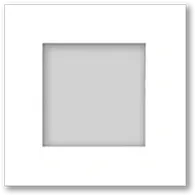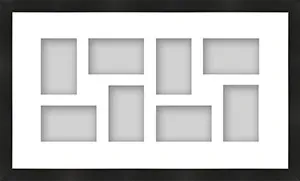What is a floater picture frame
A floater picture frame is designed for canvas and wood panel artwork. Instead of covering the edges like a traditional frame, the floater frame creates a visible shadow gap, also called a reveal, around the art. This gap makes the art look like it is floating inside the frame.
- Reveal: the visible shadow gap between art and frame
- Rabbet depth: the interior depth of the frame that accepts the art
- Face width: the visible front edge of the frame
- Back plate or base: the inside surface where the art is secured
How to measure your canvas or panel
- Measure width and height of the artwork to the nearest 1/16 inch.
- Measure thickness at the thickest point, including the stretcher bar, keys, or cradle.
- Check for proud staples or screw heads that might require extra clearance.
- Note if the canvas has a gallery wrap, which can affect reveal preference.
Write the numbers as width x height x thickness. Example: 24 x 30 x 1.5 in.
Choose reveal and frame size
The total reveal (sum of both sides) drives the floating effect. Most customers prefer a balanced look that is not too tight and not too wide.
Recommended total reveal by artwork size
- Small art up to 12 inches: 3/16 inch to 1/4 inch total
- Medium art 12 to 36 inches: 3/8 inch to 1/2 inch total
- Large art 36 inches and up: 5/8 inch to 3/4 inch total or more
To calculate the frame opening, add the total reveal to both the width and the height.
Frame opening width = art width + total reveal
Frame opening height = art height + total reveal
Example: 24 x 30 art with a 1/2 inch total reveal results in a 24.5 x 30.5 inch frame opening.
Pick the correct rabbet depth
Rabbet depth must be greater than the art thickness plus any hardware you use. Add at least 1/8 inch clearance for comfort.
| Art thickness | Minimum rabbet depth | Room for hardware |
|---|---|---|
| 3/4 in panel | 1 in rabbet | Yes |
| 1.5 in canvas | 1.75 in rabbet | Yes |
| 2 in deep canvas | 2.25 in rabbet | Yes |
If the rabbet is too shallow, the canvas may sit proud of the back or the screws may not seat. Choose the deeper option if you are between sizes.
Mounting methods for floater frames
Offset clips
Offset clips bridge from the inside of the frame to the back of the canvas or panel. They come in several offsets to match thickness. Pre drill pilot holes and do not over tighten.
Spacer blocks
Wood blocks glued or screwed to the back plate can set the reveal consistently. Paint or finish the blocks to match the frame interior.
Direct screw from back
For panels, you can pre drill and screw through the back plate into the cradle. Use washers to avoid crushing fibers and always test placement dry before final assembly.
Always test fit the art in the floater frame without hardware to confirm the reveal is even on all sides.
Finishes and wood options
- Natural wood: maple, cherry, walnut, ash, oak
- Painted: satin black, matte white, gallery gray
- Special: gold leaf accents, wire brushed texture
Match the finish to the art. Black creates a clean gallery look. Natural wood adds warmth. White blends with white walls and keeps focus on the art.
Common mistakes to avoid
- Reveal too tight. The art looks crammed and edges may rub the frame.
- Reveal too wide for small art. The frame stops supporting the composition.
- Rabbet depth too shallow. Hardware hits the back or canvas sits proud.
- No pilot holes. Screws split the wood or strip out.
- Mounting without a dry test fit. Reveal ends up uneven.
Quick sizing calculator
Enter your art size and total reveal to calculate the floater frame opening.
FAQ
What is the difference between a floater frame and a traditional frame
A traditional frame overlaps the art edge with a lip. A floater frame shows a gap all around, so the art appears to float.
Do I need a liner or mat with a floater frame
No. Floater frames are intended for canvases and panels without mats. If you want a mat, consider a traditional frame instead.
Which finish should I choose
Black for a gallery look, white for minimal, natural wood for warmth. Match or contrast the wall color and the dominant tones in your art.
Related resources
Next steps
Ready to order your floater picture frame with the correct reveal and rabbet depth









